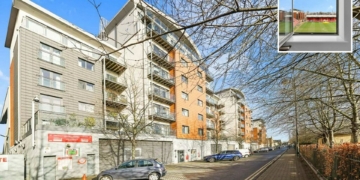A huge earthquake that rocked buildings and cut power to more than two million homes in Japan sparked fears of a Tsunami – 11 years after a tidal wave left nearly 19,000 people dead or missing in the same area.
The powerful 7.3-magnitude quake jolted the country’s northeast coast off Fukushima on Wednesday, leaving at least four people dead and 69 injured.
The earthquake left supermarkets and houses trashed while 170 miles away in Tokyo the city was plunged into darkness amid the electrical shortage.
It also triggered a fire alarm at a turbine at the crumpled Fukushima Daiichi plant, authorities said, adding they were monitoring the situation on Wednesday night.
But Japan’s nuclear authority said no abnormalities were detected at the site that went into meltdown 11 years ago when it was battered by a 9.0-magnitude quake.
Meanwhile as many as 6,820 people had to be evacuated from their homes Watari Town in Miyagi, according to local news site NHK.
The epicentre struck off the coast of Fukushima at a depth of 37 miles at 11.36pm local time – 2.36pm in the UK – triggering an advisory for tsunami waves of one metre for the coasts of northeastern Fukushima and Miyagi. But authorities later lifted the tsunami advisory and electricity was restored across the country.

Products are scattered at a convenience store in Fukushima, northern Japan Wednesday, March 16, 2022, following an earthquake

Furniture and electrical appliance are scattered at an apartment in Fukushima, northern Japan Wednesday, after a 7.3 magnitude earthquake struck

A sidewalk is pictured damaged in front of Fukushima station in Fukushima in the north east of the country in the early hours of Thursday

The earthquake triggered a huge power cut which left this block of flats in Koto district in Tokyo in darkness today

Prime Minister Fumio Kishida told reporters the government was gathering information on the situation. Pictured: The electrical shortage in Toshima ward in Tokyo

Japan’s capital city Tokyo was left in eerie darkness as the power was cut to two million people following the latest earthquake to hit the country

A tsunami advisory had warned of waves of up to one metre (three feet) for the Fukushima and Miyagi regions, but it was lifted hours later, with the Japan Meteorological Agency (JMA) saying waves of 30 centimetres (less than a foot) had been measured in the city of Ishinomaki in Miyagi.
Images showed usually bright cityscapes plunged into darkness, while video footage on social media showed a train in the capital Tokyo rocking violently and rattling gaming machines at an arcade in Fukushima.
Authorities said they were working to assess damage from the quake, as officials warned of potentially powerful aftershocks.
Government spokesman Hirokazu Matsuno said: ‘Calls have been inundating police and ambulances in Fukushima and Miyagi. We’re doing our best to assess the extent of the damage.’
Matsuno said an emergency government taskforce had been set up and warned residents of possible strong aftershocks over the next week.
He added: ‘Major aftershocks often happen a couple of days after the first quake, so please stay away from any collapsed buildings… and other high-risk places.’
At least one person died in the coastal city of Soma and dozens more were injured in the quake, local news agency Kyodo reported, as authorities said emergency departments in affected areas received numerous calls to respond to emergencies.
At least two million households were temporarily left without power in the central Kanto region, including 700,000 in Tokyo and 156,000 in the northeastern region, electricity provider TEPCO said.
But the power company had resolved blackouts in its service area by around 4:00 am (1900 GMT), Kyodo reported.
TEPCO also said it was checking operations at Fukushima nuclear plant, while the nuclear regulation authority said there were no abnormalities at Onagawa nuclear plant in northeastern Miyagi prefecture.
The Tokyo Electric Power Company Holdings, which operates the Fukushima Daiichi nuclear plant, said workers were checking for any possible damage.

An apartment is upturned by the violent earthquake that rocked Japan earlier today

An employee clears products fallen from shelves at a convenience store in Iwaki, Fukushima prefecture, northern Japan Wednesday

A restaurant floor is covered with broken plates and products in Fukushima after the table shook during the violent earthquake

People walk on a street during a black out in Tokyo in the early hours of Thursday after the earthquake on Wednesday night

People in Tokyo make a line to wait for taxis in Sendai, Miyagi prefecture, northern Japan early on Thursday morning

A shinkansen bullet train is seen derailed after the Magnitude 7.3 strong earthquake hits Northern Japan

A street is darkened due to the huge electricity outage caused by the powerful earthquake to hit Musashino on Wednesday night

Japanese Prime Minister Fumio Kishida is pictured speaking during a news conference in Tokyo amid the chaos caused by the quake
Japan’s Air Self-Defense Force said it dispatched fighter jets from the Hyakuri base in Ibaraki prefecture, just south of Fukushima, for information gathering and damage assessment.
Regional train company JR East said it was experiencing significant disruption to its operations.
A Tohoku Shinkansen bullet train derailed between Fukushima and Miyagi with some 100 people on board due to the quake, but nobody was injured, NHK said.
Prime Minister Fumio Kishida said the government was gathering information on the situation.
He said: ‘We will commit ourselves to gathering information, do our best to rescue those affected by the (quake) and communicate information appropriately.’
He also tweeted: ‘Please first take action to save your life.’ There are no immediate reports of casualties.
Japan sits on the Pacific ‘Ring of Fire’, an arc of intense seismic activity that stretches through Southeast Asia and across the Pacific basin.
The country is regularly hit by quakes, and has strict construction regulations intended to ensure buildings can withstand strong tremors.
But it remains haunted by the memory of the 2011 undersea quake in northeastern Japan that triggered a deadly tsunami and unleashed the Fukushima nuclear accident.
A minute’s silence was held on Friday, the anniversary of the disaster, to remember the some 18,500 people left dead or missing in the tsunami.
Around the stricken Fukushima plant, extensive decontamination has been carried out, and this year five former residents of Futaba, the region’s last uninhabited town, returned to live there on a trial basis.
Around 12 percent of Fukushima was once declared unsafe but no-go zones now cover just 2.4 percent of the prefecture, although populations in many towns remain far lower than before.

People shop in darkness in a store in a residential area during the power outage in Koto district in Tokyo on Wednesday evening

Houses and buildings are seen in an electric stoppage at Toshima ward in Tokyo after the huge earthquake shook the capital late Wednesday

A worker of meteorological bureau speaks during a press conference in Tokyo Thursday following the earthquake

:quality(70):focal(792x297:802x307)/cloudfront-eu-central-1.images.arcpublishing.com/irishtimes/PBASXBG6EXJ2NNIFVJVQQYTPJE.jpg?resize=1200,630&ssl=1)













